
Photos by Frank Lanier
228
Practical Sailor last reviewed water pumps in the June 2003 issue. A whole new crop of pumps has hit the market since then, so we figured it was high time to take a fresh look at the heart of a boat’s freshwater system.
The trend toward “smart” pumps noted in our last test has expanded into the realm of “intelligent” pumps. Back then, “smart” simply meant that a pump used technologies like variable-power and transducer-like switches, allowing the pump to sense demand and automatically alter the speed of the pump’s motor to increase or decrease output, eliminating the need for an accumulator tank. Our current test group highlights the evolution toward even smarter pump technology. Some “intelligent” pumps monitor and respond to variations in the freshwater system as a whole, while others alert users when a problem occurs and help identify where the problem is.
This test included some smart pumps as well as basic pumps, and as with our last test, it focused on affordable freshwater pumps with modest gallons-per-minute output ratings. What makes a pump stand out is not just a good flow rate, but also a lack of noise, ease of plumbing, low amp draw, and compact size. The ideal pump will have a balanced mix of these qualities, but the right pump for one boat doesn’t always meet the needs of another. It depends on which of these qualities a boat owner considers a priority.
Pump flow rate is typically one of the first things a buyer looks at; however, advertised flow rates rarely are realized at the faucet. Manufacturers’ ratings are figured for simple horizontal outputs and don’t take into account hoses, turns, strainers, or check valves—just the flow straight into the input fitting and out the output fitting. It may seem like manufacturers are playing some sort of shell game, but it’s really the only fair way to rate the pumps due to the wide range of variables that could be involved.
Rating pump output using a real-world installation would require allowances for twists and turns in the line, the height of the “lift,” and various other elements. Battery charge is crucial, as batteries with a low-peak voltage deliver far less water than those that are fully charged. Filters are another potential problem: Intake strainers are alright—they have relatively coarse screens—but the denser cartridges found in filters can affect output and overwork the pump. If you have a certain output flow rate in mind and plan on installing a filter, it’s always a good idea to go with a slightly bigger pump to overcome the increased resistance.
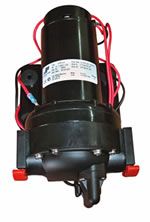
150
What We Tested
We tested 10 diaphragm pumps and one gear pump from five manufacturers—Shurflo, Jabsco/ITT, Johnson, Whale, and Groco—for this evaluation. All of the test products met Practical Sailor’s general requirements of providing modest gallons-per-minute outputs at a reasonable price.
From Shurflo, a leading supplier to the marine and RV market, we tested the Aqua King Premium 4.0 and the Aqua King Standard 3.0 pumps. Northern Ireland-based Whale pumps sent us three units to test: the Universal UF0815, Universal UF1815, and its new Fresh IC (Intelligent Control) pump. From Jabsco, a division of ITT/Rule, we tested the Par-Max 2.9 and 4.3 pumps, as well as the V-Flo 5.0 unit. Johnson Pumps, which is part of SPX Flow Technology, provided two pumps: the Aqua Jet WPS 4.0 and 5.2. A third-generation manufacturer of marine hardware, Groco supplied its WSG-1 Water Pressure System, which comes with the pump and an accumulator tank.
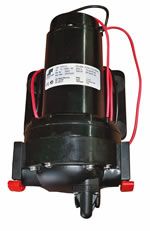
150
Most of the test pumps are multi-diaphragm pumps. The internal rubber diaphragms are actuated by an electric motor that translates rotary motion into pumping action to move the diaphragms. Another diaphragm, when it’s under pressure, pushes against a microswitch that turns off the pump motor once the right pressure has been reached.
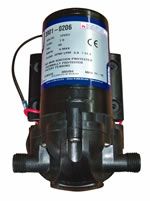
150
The Groco, however, is a gear pump. Gear pumps comprise only two moving parts: a large gear (rotor) and a small gear (idler). Once water has entered through the suction port and filled the pump head, the gear teeth mesh to form a seal that forces the water out of the discharge port.
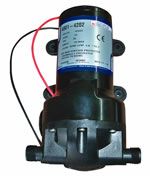
150
JOHNSON
Johnson Pumps provided two units, the Aqua Jet WPS 4.0 and the slightly larger Aqua Jet WPS 5.2 model. Both were well constructed, moderately priced, and performed well overall. The WPS 5.2 had the highest output of the test group, was fairly quiet, and rated in the middle of the pack for power consumption. The WPS 4.0 unit slightly exceeded its advertised output of 4 GPM, was the second most quiet, and rated favorably in the power usage category. It was also the only pump to score within the top five of the three main performance categories.
However, the manufacturer recommends also including an accumulator tank in the plumbing setup. Accumulator tanks are pressurized tanks designed to reduce pump cycling, allowing a pump to build up some reserve pressure. An accumulator tank doesn’t have to be used (even if it’s recommended) for a pump to work, but going without one means the pump will cycle on a lot more. Most of the newer pump designs eliminate the need for an accumulator tank, which means one less component to buy, install, and maintain.
Bottom line: Both Johnson pumps performed well in tests. The 4.0 unit gets a PS Recommendation for a higher-capacity pump.
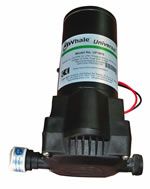
150
SHURFLO
Both Shurflo pumps we tested, the 3-GPM Aqua King Standard 3.0 (model 3901-0206) and the 4-GPM Aqua King Premium 4.0 Fresh Water Pump (model 4901-4202), were well constructed, moderately priced, and performed at or near their advertised output in tests. Both also use threaded fittings.
The Standard consumed the least amount of power of all those tested and was at the low-noise and high-output ends of the findings spectrum. The Premium had average output, but it was noisier and drew more amps than most other test pumps.
Bottom line: Both Shurflo pumps were solid performers. We recommend the Aqua King Standard for those who prefer a belt and suspenders approach to connections.
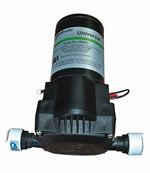
150
WHALE
Whale provided three units for our test, the Universal UF0815, the Universal UF1815, and their Fresh Intelligent Control (IC) FW5082B model.
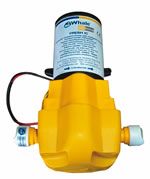
150
The Whale products were the only pumps tested that are advertised as suitable for use with both fresh and salt water. Collective features testers liked about the Whale pumps included the adjustable mounting feet, Whale’s extremely easy to operate quick-connect system, and the inclusion of intake strainers with each pump.

150
The Fresh IC—one of the more technologically advanced pumps tested—continued to run 9 seconds after the test system’s shutoff valve was closed. Most other pumps shut down once pressure was built back up, usually within 3 seconds or so. While this seemed to testers to be an annoying habit, Whale explained that the pump over-runs by design, to protect the pump from cycling on shutdown.
The UF0815 exceeded its advertised GPM, was the quietest pump tested, and drew a miserly 3.3 amps.
All of the Whale pumps tested come with a two-year warranty. All of the other test pumps offer three-year coverage, except the Groco, which comes with a one-year warranty.
Bottom line: Although it didn’t have the highest output, the petite Whale UF0815 exceeded its rated GPM and performed well for its size. We recommend it as a quality light-duty pump.

Photos by Frank Lanier
228
0)]
JABSCO
Testers evaluated three Jabsco/ITT products: the Par-Max 2.9, Par-Max 4.3, and the V-Flo 5.0. The 2.9 model, which is suitable for systems with three or more outlets, had the lowest output of the test group—not a big surprise given its lower GPM rating. It was, however, one of the five most quiet and least power-hungry pumps. It also was the least expensive pump tested.
Essentially a larger version of the 2.9, the Par-Max 4.3 is designed for use with systems that have five or more outlets. It tied with the Whale UF1815 for the third-highest output, but it was fairly noisy and required more power than half the test field.

Photos by Frank Lanier
228
1)]
The V-Flo (variable flow, constant pressure) is designed to automatically run diagnostics to detect common failures (out of water, plumbing leaks, over current, under current, low voltage, and over voltage), and if the diagnostic discovers a problem, the pump will stop, identify the root cause, and will help identify the problem via a blinking light at the pump’s remote control panel. The remote panel is a small (¾ inch x ½ inch) on/off rocker switch with a single light that blinks to indicate a problem with either the pump (single blink) or the system (double blink).

Photos by Frank Lanier
228
2)]
Testers liked the trouble-shooting feature offered by the V-Flo, which was a top output performer, but it was also the loudest pump tested.

Photos by Frank Lanier
228
3)]
Bottom line: The Par-Max 2.9 gets the Budget Buy honor.
GROCO
Constructed of bronze and stainless steel, the Groco WSG-1 Water Pressure System is a beefy gear pump with an advanced timer/pressure switch that shuts off the pump if it runs continuously for more than 10 minutes or dry for more than 30 seconds. If the pump shuts itself off, it can’t be cycled on again for 15 seconds.
The WSG-1, the only non-plastic test pump, was the most expensive we tested, but it does come with an accumulator tank. The older-style pump uses an accumulator to reduce pump cycling. This means the pump won’t have to turn on every time someone turns on the faucet. According to Groco, having an accumulator means better water-temperature consistency during showers and sufficient GPM for more than one appliance (shower and galley faucet, for example) to be used at a time.
The Groco uses threaded hose barb-type fittings, which can easily be found, but they were not provided with pump.
Bottom line: While the noisy Groco has the shortest warranty and used the most power, it’s built like a tank and likely would handle hard service for many years.
Conclusion
Selecting a pump is a balancing act between performance, durability, and features; there’s no one-size-fits all solution. Increase the power and the output goes up, but so do noise and amps. Quick-connectors and trouble-shooting pumps offer convenience, but there’s also a lot to be said for simplicity and durable design.
Based on our “ideal” criteria, the Whale UF0815 gets the nod for a low-capacity pump. The well-constructed Par-Max 2.9 gets the PS Budget Buy. Based on performance, the Johnson 4.0 garnered a solid Recommended for a higher-capacity pump, but we’d like to see its quick-connector design beefed up. The Shurflo Aqua King Standard is our recommended pump for those who are less keen to use plastic quick connections.
The quest for pump nirvana continues as pumps continue to evolve. Variable-power pumps that sense pressure and adjust power to the flow are now commonplace, while “smart pumps” are being eclipsed by “intelligent” pumps, which not only shut down if a problem occurs, but can even troubleshoot the system.
Who knows what features we’ll see in future tests? Pumps with verbal prompts? Or perhaps ones that deliver a mild shock to guests who take long showers? The only certainty is that it’s the consumer who will continue to reap the benefits of advancing pump technology.
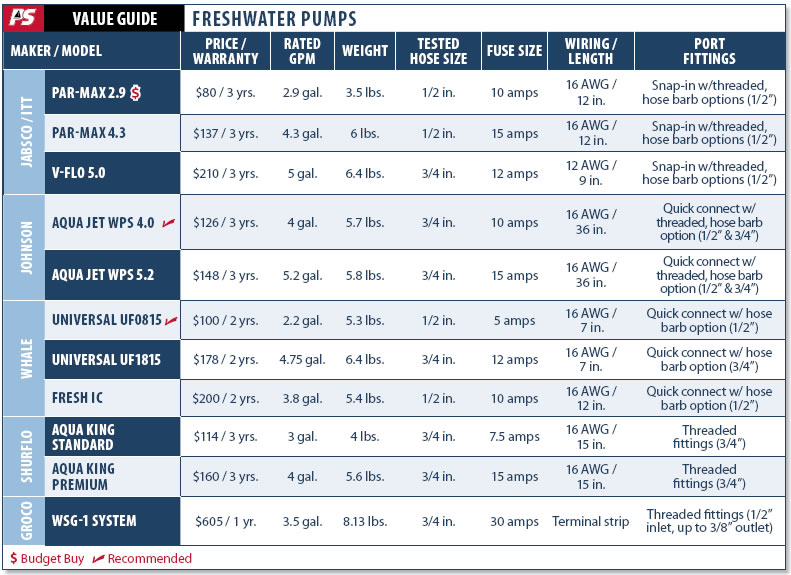
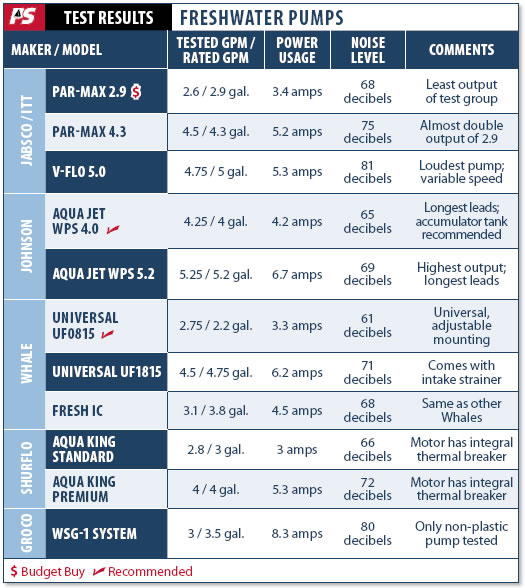
































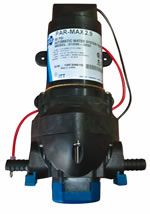





Water is a necessity and not a luxury in boats. From dishwashing to showering to drinking, it is crucial to have access to water. The freshwater pump will make such possible. It ensures the availability of water onboard while maintaining high pressure. 🙂
One test criteria that could be included is the pump’s performance under low voltage. I have the Jabsco V-Flo onboard and as soon as the house bank dwindles to 12.4V, the sensor does not allow the pump to properly complete its charge of the system after the faucet is closed. Instead, it continues a very low speed cycling with no end. It is barely audible with any background noise and only serves to further drain the batteries. I think any system that is “smart” should be able to perform to 12V. Ours did not come with any panel described above for trouble shooting. Having to fire up a generator when the battery still has ample charge, just to keep the pump happy, is less than desirable.